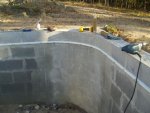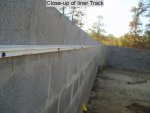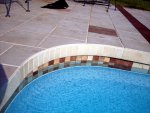I have to replace my liner and now is the best time to some required maintainance and I have a lot of questions. I am a DIYer, so this will be all my own labor.
The pool a bit more than 20 years old and I inherited with the house. If I were building new, it would probably look a lot different. It just a boring rectangle. I put a lot of information in my "introduction" thread, but I'll post a couple of pictures to start discussion. Here is an overview shot and a close-up if the liner, coping and removed automatic cover.



Several questions?
This pool seems to have concrete sides, al least to where it slopes. I won't know for sure until I take the liner out. If it is concrete, can it be plastered? I'm guessing not, but why not ask?
The coping is bullnosed brick. Below the coping is one course of brick above the liner. It need a complete tuckpoint job. As you can see in the pictures, the automatic pool cover was removed and the hole concreted in. I need to procure at least 20 feet of brick coping, so I'm thinking it would be easier to tear out the complete coping and do something different. I'm thinking pre-cast sections of coping. I'm still learning about available products, but it looks like coping is 2" thick, so I have to do something about the extra course of brick. What do I do there that will look good? Any decking would have to salt water tolerent.
This pool does not have a main drain. Any chance its worth putting in? I do not have chemistry problems, but with our high solar load out here in the desert, we do stratify quite a bit and a bottom drain I'm thinking will stir up the water more. The pool has one skimmer and one return and an extra return that was originally for a pool cleaner (which has since been removed). Piping is 1 1/2".
Since there is substantial wiring in the dirt near where the old automatic cover was, I'm guessing ther used to be a light niche in the deep end. Whether there was or wasn't, is it worth putting it in? Since I have electric, can a light be added without removing the existing deck. If there is a light niche under the liner, I would suspect its in poor shape and would have to be replaced anyway.
The pool deck is in good shape for 20 year old concrete. No heaving. Just a few hairline cracks and minor spalling. I see no need to remove. I do need to deal with the plastic expansion joints. They are pretty much toast. What is the standard repair?
Pool liner? There originally was a receiver fastened to the top of the bond beam prior to the course of brick and coping installation. When this liner was installed, that was abandoned and a vertical receiver was installed. The screws for this receiver are quite rusty and since its plastic, should I just plan of replacing the liner receiver as well? One thing I don't like is that the receiver ends up being proud of the wall 1/2" so the liner isn't exacally up aginst the wall right at the top. I assume this is standard and not a problem, but I'll ask anyway.
Automatic cover? Worth re-installing? Can it be done by a DIYer? Cost? I'm guessing north of $5k, and if so, it ain't going to happen.
Thanks for any and all comments...
The pool a bit more than 20 years old and I inherited with the house. If I were building new, it would probably look a lot different. It just a boring rectangle. I put a lot of information in my "introduction" thread, but I'll post a couple of pictures to start discussion. Here is an overview shot and a close-up if the liner, coping and removed automatic cover.



Several questions?
This pool seems to have concrete sides, al least to where it slopes. I won't know for sure until I take the liner out. If it is concrete, can it be plastered? I'm guessing not, but why not ask?
The coping is bullnosed brick. Below the coping is one course of brick above the liner. It need a complete tuckpoint job. As you can see in the pictures, the automatic pool cover was removed and the hole concreted in. I need to procure at least 20 feet of brick coping, so I'm thinking it would be easier to tear out the complete coping and do something different. I'm thinking pre-cast sections of coping. I'm still learning about available products, but it looks like coping is 2" thick, so I have to do something about the extra course of brick. What do I do there that will look good? Any decking would have to salt water tolerent.
This pool does not have a main drain. Any chance its worth putting in? I do not have chemistry problems, but with our high solar load out here in the desert, we do stratify quite a bit and a bottom drain I'm thinking will stir up the water more. The pool has one skimmer and one return and an extra return that was originally for a pool cleaner (which has since been removed). Piping is 1 1/2".
Since there is substantial wiring in the dirt near where the old automatic cover was, I'm guessing ther used to be a light niche in the deep end. Whether there was or wasn't, is it worth putting it in? Since I have electric, can a light be added without removing the existing deck. If there is a light niche under the liner, I would suspect its in poor shape and would have to be replaced anyway.
The pool deck is in good shape for 20 year old concrete. No heaving. Just a few hairline cracks and minor spalling. I see no need to remove. I do need to deal with the plastic expansion joints. They are pretty much toast. What is the standard repair?
Pool liner? There originally was a receiver fastened to the top of the bond beam prior to the course of brick and coping installation. When this liner was installed, that was abandoned and a vertical receiver was installed. The screws for this receiver are quite rusty and since its plastic, should I just plan of replacing the liner receiver as well? One thing I don't like is that the receiver ends up being proud of the wall 1/2" so the liner isn't exacally up aginst the wall right at the top. I assume this is standard and not a problem, but I'll ask anyway.
Automatic cover? Worth re-installing? Can it be done by a DIYer? Cost? I'm guessing north of $5k, and if so, it ain't going to happen.
Thanks for any and all comments...







